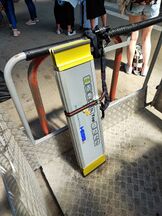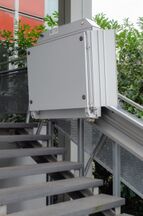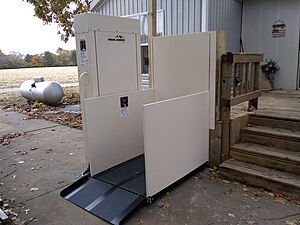Proposal:Wheelchair lifts and ramps on platforms
| The Feature Page for this approved proposal is located at Key:platform_lift |
| The Feature Page for this approved proposal is located at Key:ramp:portable |
The content of this proposal has been archived to avoid confusion with the current version of the documentation.
| Lifts and ramps on platforms and stairs for wheelchair users | |
|---|---|
| Proposal status: | Approved (active) |
| Proposed by: | Wielandb on behalf of OPENER |
| Tagging: | platform_lift=(yes/no/vertical/inclined) platform_lift:portable=(yes/no) and ramp:portable=(yes/no) platform_lift:seat=(yes/no) |
| Applies to: | |
| Definition: | Different means that help people in wheelchairs to overcome stairs in general and to board public transport vehicles in particular. |
| Rendered as: | hidden |
| Draft started: | 2023-06-15 |
| RFC start: | 2023-07-11 |
| Vote start: | 2023-08-11 |
| Vote end: | 2023-08-28 |
Proposal
This proposal wants to establish the follwing tags:
- platform_lift:portable=(yes/no) and ramp:portable=(yes/no)
- platform_lift:seat=(yes/no)
This proposal also wants to extend the following tag:
- ramp=*
Platform
The tags ramp=yes and ramp:portable=yes are used to indicate if there are platform-bound ramps helping wheelchair users to enter or leave a public transport vehicle (mostly trains).
The tags platform_lift=yes and platform_lift:portable=yes are used to indicate if there are platform-bound lifts helping wheelchair users to enter or leave a public transport vehicle (mostly trains).
The tags ramp=* and platform_lift=* can be further detailed by sub-tags like *:maxwidth:physical=*, *:maxlength:physical=*, *:maxweight=* and *:supervised=* (More information about that below).
The tags above should be placed on the element that represents the platform, e.g. public_transport=platform for a PTv2 platform.
The tag service_times:wheelchair=* is used to specify when service workers are available to operate portable lifts and ramps.
This tag should be placed on the element that represents the public_transport=stop_area. If such an element doesn't exist, the tag is added to the element that represents the platform, e.g. public_transport=platform for a PTv2 platform.
Stairs
We propose to also tag platform lifts for wheelchair users to overcome steps and stairs with: platform_lift=(yes/no/vertical/inclined) The tag should be added to elements with highway=steps including additional sub-tags like platform_lift:maxwidth:physical=*, platform_lift:maxlength:physical=* and platform_lift:maxweight=*. A new sub-tag platform_lift:seat=* is proposed to indicate whether the platform lift provides a foldable seat. Overall the tagging is oriented at the already existing ramp=* tag.
Rationale
|
|
Note: The platform in platform_lift=* should not be confused with the platform of a public transport stop or station. In this case the platform is the area where wheelchair users roll onto to be lifted up, in contrast to a seat mostly used on incline stair lifts. |
General
The early proposal suggested the tags wheelchair:portable_ramp=* + wheelchair:portable_lift=* for portable ramps respectively lifts at platforms and wheelchair:lift=* for platform lifts at stairs. The idea behind it was that they function as a further level of detail to the broad wheelchair=* tag like wheelchair:description=* but more specific and machine-readable.
Others however criticized that these tags may be mistaken for *:wheelchair=* tags, where wheelchair=* acts as a sub tag to indicate the accessibility of a certain feature. Additionally the lifts found at platforms and stairs share a common ground which is not reflected by our earlier proposed tags. Therefore we changed the scheme from acting as a more detailed description of wheelchair=*, to actually describe the feature or property platforms and stairs might have.
Some might argue that we should use the existing tag ramp:wheelchair=yes instead of ramp=yes and therefore also propose platform_lift:wheelchair=yes. Tags like *:wheelchair=* serve as a less detailed mapping method. We prefer mapping actual properties of the features from which the accessibility for each individual person can be derived from. Therefore we do not explicitly propose platform_lift:wheelchair=*.
We decided for the sub-tag *:portable=* (instead of making it a value of platform_lift=* or ramp=*) because in reality vertical and even inclined portable platform lifts (see e.g. this manufacturer) exist. This way the tagging schema is most flexible and can be used in other scenarios and contexts.
We decided against using elevator=* or highway=elevator because a platform lift differs from an elevator in the following points:
- platform lifts only transport one person at a time, while elevators can often transport multiple people
- platform lifts are usually designated for mobility impaired people, while elevators are for general usage (transporting goods, bicycles, strollers, etc.)
- platform lifts are usually open or only partially enclosed and do not have doors, while elevators are typically enclosed structures with doors consisting of a car or cabin
- platform lifts usually transport between only one floor while elevators transport between one to multiple floors
Therefore reusing the elevator=* or highway=elevator tags for platform lifts might lead people to misinterpret them as an usual elevator also because they often occur in the same places.
We also decided against lift=* in favor of platform_lift=* because lift is basically a synonym for elevator and could be misinterpreted on its own.
Acknowledgement
While in most cases platform lifts can clearly be distinguished from elevators it is undeniable that there is a natural overlap. Therefore stationary platform lifts can be mapped as a separate node (vertical platform lifts) or way (incline platform lift) with the standard highway=elevator tag. However mappers then should additionally add: wheelchair=designated + capacity=1 to denote the restrictions and limitations of a platform lift. Any further attributes like maxwidth:physical=* should be added without the platform_lift:*=* prefix. This may be used in micro mapping scenarios or in rare cases where a platform lift is installed without nearby stairs.
Platform
On public transport platforms wheelchair=(yes/no) is used to describe the accessibility of a platform. However it does not provide information whether wheelchair users can enter or exit the vehicle. This depends on many different aspects of the platform like its height, but also on the vehicle like its door width or entrance height. For trains with a non-level-access portable ramps and lifts can be used to overcome the vertical respectively horizontal gap.
The tags platform_lift=* + platform_lift:portable=* or ramp=* + ramp:portable=* are placed at the platform to indicate the existence of the respective feature.
If requested on time these devices are operated by service workers of the transport company to help wheelchair users to get on or off the train. Whether or not these devices are operated by a service worker can be indicated by the tag *:supervised=*. If omitted the local convention is assumed (in Germany *:supervised=yes would be assumed).
If *:supervised=yes is set, it almost certainly means that the portable lifts and ramps can't be used 24/7 but rather have certain service times. Those can be defined with service_times:wheelchair=*. For Germany these service times can be found at DB Station & Service. We decided against opening_hours:wheelchair=* because a public transport station or stop is usually 24/7 open for everyone, but not everyone can enter or exit a vehicle without the support of service workers all the time.
This information in combination with the vehicle type is an indicator for the accessibility of a public transport route.
Stairs
Stairs are barriers for mobility-impaired people like wheelchair users. For them elevators or ramps are crucial to overcome them. For less populated places or places where ramps and elevators cannot be installed, platform lifts can serve as an alternative aid.
We decided against naming the tag stair_lift=* for platform lifts. Stair lifts allow people to sit on a chair to be lifted up the stairs on which the lift is mounted. Therefore they only transport people without a wheelchair or mobility scooter. Additional information: https://en.wikipedia.org/wiki/Wheelchair_lift While the term stair_lift is also used as a general term for (chair or platform) lifts at stairs, it is not agnostic about the feature it belongs to due to the term stairs. Thus it would only makes sense to be used at stairs and not on other features which we consider another weak point of the tag stair_lift=*.
Tagging
Platform
- ramp=(yes/no) + ramp:portable=yes on platforms indicate if a portable ramp is available
- platform_lift=(yes/no/inclined/vertical) + platform_lift:portable=yes on platforms indicate if a portable platform lift is available. inclined and vertical describe the kind of platform lift in more detail. However on a public transport platform an inclined platform lift is unlikely.
Stairs
- platform_lift=(yes/no/inclined/vertical) on stairs indicate if a platform lift is available. inclined and vertical describe the kind of platform lift in more detail.
- platform_lift:seat=(yes/no) is used to specify if the lift has a foldable seat
General
- platform_lift=inclined describes a platform lift which follows the stairs at an incline
- platform_lift=vertical describes a platform lift which only moves in a vertical direction
- ramp:length=* is used to specify the ramp's (unfolded/extended) length. Length is the dimension along the users movement direction. Measured in meters.
- ramp:maxwidth:physical=* is used to specify the ramp's width of the usable space. Width is the dimension crosswise to the users movement direction. Measured in meters.
- ramp:maxweight=* is used to specify the ramp's maximum load capacity. Measured in tons (In compliance to Default_units).
- ramp:supervised=* is used to specify whether or not the ramp is operated by a service worker. If omitted the local convention is assumed.
- platform_lift:maxlength:physical=* is used to specify the lift's length of the usable space. Length is the dimension along the users movement direction. Measured in meters.
- platform_lift:maxwidth:physical=* is used to specify the lift's width of the usable space. Width is the dimension crosswise to the users movement direction. Measured in meters.
- platform_lift:maxweight=* is used to specify the lift's maximum load capacity. Measured in tons (In compliance to Default_units).
- platform_lift:supervised=* is used to specify whether or not the platform lift is operated by a service worker. If omitted the local convention is assumed.
- service_times:wheelchair=* is used to specify the time when supervised ramps and lifts are actually accessible/ usable.
The marked line corresponds to the movement direction, so the measured distance is portable_lift:maxlength:physical=*.
The marked line goes perpendicular to the movement direction, so the measured distance is portable_lift:maxwidth:physical=*.
Examples
Platform
| Example Image(s) | Tagging |
|---|---|

|
|
  
|
|
  
|
|

|
Stairs
| Example Image(s) | Tagging |
|---|---|
 
|
|
 
|
Edge case - Platform lift without nearby stairs
| Example Image(s) | Tagging |
|---|---|

|
Rendering
No special rendering is suggested in general-purpose map styles such as carto. However, special interest map styles may adopt a special rendering.
Features/Pages affected
External discussions
Comments
Please comment on the discussion page.
Voting
Voting on this proposal has been closed.
It was approved with 9 votes for, 1 vote against and 1 abstention.
 I approve this proposal. --RobinJulien (talk) 11:32, 11 August 2023 (UTC)
I approve this proposal. --RobinJulien (talk) 11:32, 11 August 2023 (UTC) I approve this proposal. --Gymate (talk) 13:30, 11 August 2023 (UTC)
I approve this proposal. --Gymate (talk) 13:30, 11 August 2023 (UTC) I approve this proposal. -- Something B (talk) 23:11, 11 August 2023 (UTC)
I approve this proposal. -- Something B (talk) 23:11, 11 August 2023 (UTC) I approve this proposal. --scai (talk) 06:09, 12 August 2023 (UTC)
I approve this proposal. --scai (talk) 06:09, 12 August 2023 (UTC) I oppose this proposal. Separate elevators (not part of the stairs, but existing next to it) should be mapped as elevators, not as steps. See the example _above_ the edge case. Nothing prevents it from being used like a regular (small) elevator. --Famlam (talk) 16:26, 13 August 2023 (UTC)
I oppose this proposal. Separate elevators (not part of the stairs, but existing next to it) should be mapped as elevators, not as steps. See the example _above_ the edge case. Nothing prevents it from being used like a regular (small) elevator. --Famlam (talk) 16:26, 13 August 2023 (UTC) I have comments but abstain from voting on this proposal. In general, I support this proposal. But there are a few points that still need refinement. As Famlam wrote, the last example is not an edge case, but a clear example of when to use already existing tagging. The example above it are the edge cases which can be mapped separately or not. For these a `platform_lift=separate` and `wheelchair=use_separate_lift` (name to be refined) tag should be introduced on the stairs to point to the nearby, separately mapped lift. --Mueschel (talk) 12:36, 20 August 2023 (UTC)
I have comments but abstain from voting on this proposal. In general, I support this proposal. But there are a few points that still need refinement. As Famlam wrote, the last example is not an edge case, but a clear example of when to use already existing tagging. The example above it are the edge cases which can be mapped separately or not. For these a `platform_lift=separate` and `wheelchair=use_separate_lift` (name to be refined) tag should be introduced on the stairs to point to the nearby, separately mapped lift. --Mueschel (talk) 12:36, 20 August 2023 (UTC) I approve this proposal. Good job --Gendy54 (talk) 13:20, 20 August 2023 (UTC)
I approve this proposal. Good job --Gendy54 (talk) 13:20, 20 August 2023 (UTC) I approve this proposal. Thanks for the detailed information, but the"Announcement on the tagging mailing list" link is broken. Could someone please look into it? --Adiatmad (talk) 08:55, 21 August 2023 (UTC)
I approve this proposal. Thanks for the detailed information, but the"Announcement on the tagging mailing list" link is broken. Could someone please look into it? --Adiatmad (talk) 08:55, 21 August 2023 (UTC) I approve this proposal. --Makiwolf (talk) 09:56, 21 August 2023 (UTC)
I approve this proposal. --Makiwolf (talk) 09:56, 21 August 2023 (UTC) I approve this proposal. --mnalis (talk) 17:07, 26 August 2023 (UTC)
I approve this proposal. --mnalis (talk) 17:07, 26 August 2023 (UTC) I approve this proposal. --Nw520 (talk) 10:18, 28 August 2023 (UTC)
I approve this proposal. --Nw520 (talk) 10:18, 28 August 2023 (UTC)


